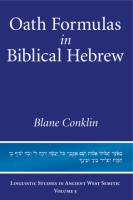Oath Formulas in Biblical Hebrew
Blane Conklin
The eponymous protagonist of the biblical story of Ruth, a Moabite widow, is so desperate to follow her widowed mother-in-law back to Israel that she swears an oath. Regardless of the translation one may choose, the sense is the same: Ruth promises to stick by Naomi’s side for at least as long as they both shall live. Ruth’s intention with respect to the two widows’ proximity once they cross the final river is not so unanimous in the translations, however. According to the NRSV, Ruth says:
- Description
- Table of Contents
(1) “May the Lord do thus and so to me, and more as well, if even death parts me from you!”
The njpsv is representative of many other translations with its rendering:
(2) “Thus and more may the Lord do to me if anything but death parts me from you.”
The difference may seem trivial, but the contradiction between the italicized phrases is total. Either death will not ultimately separate them, or it will, in Ruth’s view. The issue here is not a theological one, nor is this an archaeological issue. Rather, the issue is of a linguistic nature. What does the Hebrew phrase mean?
The solution to the problem is fairly straightforward. The first step is to recognize that Ruth’s statement is an oath. Oaths often employ formulaic, elliptical phrases. Therefore, it is necessary to gather together in one place as many of these formulas as possible so that the patterns, tendencies, and divergences may be seen within a larger matrix. Conklin’s study intriguingly compiles precisely these phrases and formulas in order to solve the mystery of interpreting Biblical Hebrew oath formulas.
Abbreviations
1. Introduction
1.1. The Problem
1.2. Oaths as Speech Acts
1.3. The General Structure of Oaths
1.4. Previous Scholarship
1.5. Plan
2. The Authenticating Element
2.1. Raising of a Hand
2.2. Invocation of Witness(es)
2.3. Swearing
2.4. “Thus Will X Do to Y”
2.5. “(By) the Life of X”
2.6. Conclusion
3. Conditionally Formulated Oaths
3.1. Summary of Secondary Literature on Conditional-Clause Syntax
3.2. Special Study of Conditional-Clause Syntax in 1 Samuel
3.3. Oath Content Introduced by ʾm
3.4. Oath Content Introduced by ʾm-lʾ
3.5. Conclusion on Conditionally Framed Oaths
4. Oaths Marked with ky
4.1. Summary of ky Syntax from Secondary Literature
4.2. Special Study of ky Syntax in 1 Samuel
4.3. Oath Content Introduced by ky
4.4. Conclusion
5. Exceptions and Objections
5.1. Oath Content Formulated in Other Ways
5.2. Relationship of Markers of Oath Content to Authenticating Elements
5.3. The Alleged Function of ky-ʾm as an Oath Marker
5.4. Conclusion
6. Conclusions
7. Appendix: Oath Formulas in Other Semitic Languages
7.1. Northwest Semitic
7.2. Akkadian
7.3. Classical Arabic
7.4. Conclusion
Bibliography
Indexes
Mailing List
Subscribe to our mailing list and be notified about new titles, journals and catalogs.




